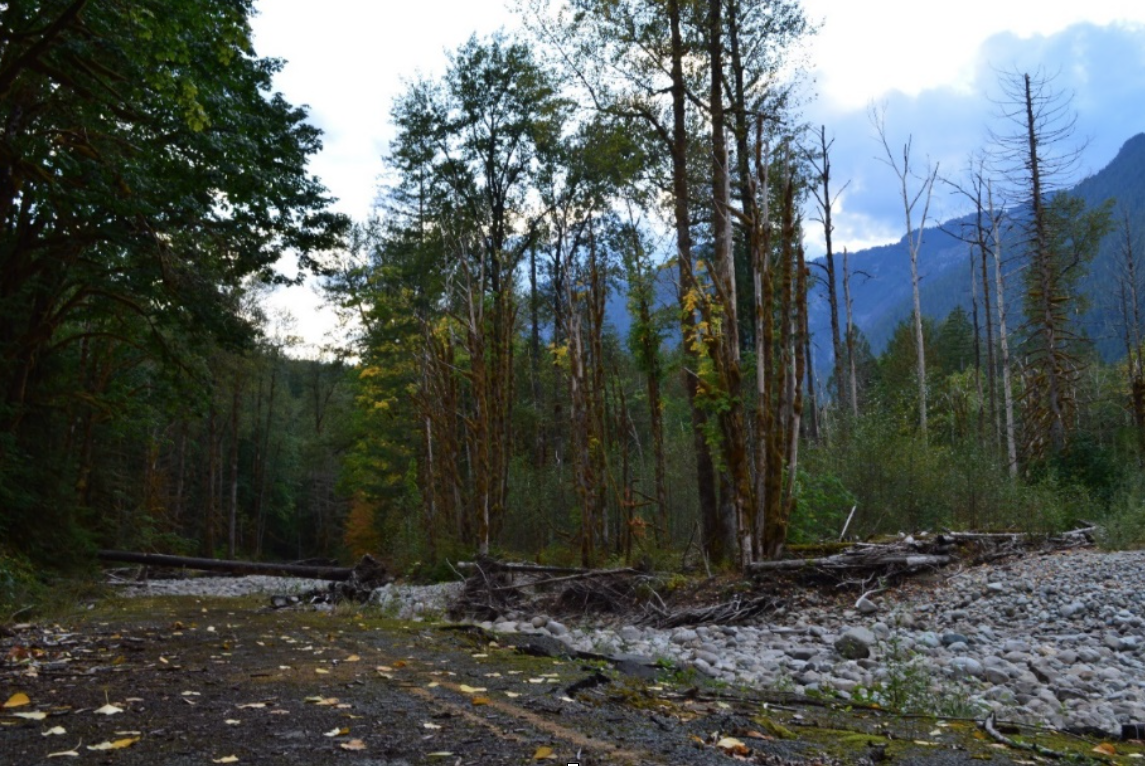The curious case of the disappearing maple
Climate change is a lead suspect
Passant Rabie • December 5, 2018

Dying bigleaf maple trees starting to lose their lush crowns (Image courtesy of Jacob Betzen)
Daniel Omdal has driven past the same bigleaf maple tree for decades, often stopping his car to take pictures of its full, expansive crown. In the past few years, however, the tree has started to look more lopsided, with bare branches and patches in its crown with little to no growth.
To Omdal, a forest pathologist, it seemed like an obvious case of an insect infestation. If not, perhaps some kind of disease: a damaging fungus, wilt or a rogue bacterium. Whatever it was, it wasn’t isolated to one tree. The extent of sick bigleaf maples was alarming, and Omdal wasn’t the only one who was worried.
Omdal’s colleagues at the Washington State Department of Natural Resources, where he has worked since 1997, had noticed the same symptoms in many other bigleaf maples. So had many residents of the region, who called the state to report their concerns. The issue had also been occurring nationwide, with reports of sharp declines of urban tree populations in different states, such as the oak tree in Southern California. In Washington, the problem was hard to miss: Bigleafs, also known as Oregon maples, are a staple of the Pacific Northwest landscape.
“These calls became more frequent, I couldn’t so easily dismiss the concerns,” Omdal says. In 2011, he became part of a state-led team investigating the bigleaf die-offs.
The group discovered that about 40 percent of bigleaf maple trees in Washington state are declining, says Jacob Betzen, a graduate student at the University of Washington’s School of Environmental and Forest Sciences, who has been working with the investigative team for the past two years.
The first suspect on their list was Armillaria, a fungus that causes the roots of the tree to rot. But when the team tested hundreds of trees for it, most of their results came back negative. Then, the researchers tested for another fungus called verticillium wilt. Also negative. Often, a few trees would be infected, but it was never widespread enough to be the primary cause of the species’ decline.
Omdal collected soil samples to test in the lab to look for other causes. Every time his team followed a new lead, it didn’t pan out. “We would come to a dead end,” Omdal says.
Patrick Tobin, Betzen’s advisor and a specialist in disturbance ecology, added, “It’s been puzzling, there’s no smoking gun here.”
Then Betzen noticed something curious about the die-offs. They are much more common in developed landscapes and areas that are warmer, drier and closer to roads. That led to a new suspect: climate change. “It seemed probably related to recent weather patterns, it’s getting hotter and drier in Washington in recent years,” Betzen says. The group’s results won’t be published until Betzen concludes his research at the end of the year, but Tobin is confident that the key driver causing bigleaf maple die-offs is, in fact, climate change.
Shifts in climate, he says, have put the trees “at the edge of what they can tolerate.” Stressed by the hotter, drier conditions, they are at a tipping point at which any other factor, whether an insect infestation or a fungal disease, would have a deadlier impact than it would normally.
One reason the team is confident about its conclusions is that the same problems are occurring in many other places, affecting other species of trees, especially in cities and suburbs. A recent U.S. Forest Service study found that urban areas in the U.S. have lost about 36 million trees per year from 2009 to 2014. That’s an annual loss of 175,000 acres of tree cover — an area almost as large as New York City.
David Nowak, a senior scientist at the U.S. Forest Service and the study’s author, says his team looked at satellite photographs in every state, and found that each one had lost tree cover. “We’re in a downward trend,” he says.
One in three trees in the U.S. is planted, while the rest grow through natural regeneration. What alarms Nowak is that many trees are dying before they can reproduce — most likely due to climate-related stress in combination with factors such as changes in soil moisture and an increase in paved surfaces nearby. Much like the case of the bigleaf maples, these die-offs cannot be pinned to one specific cause.
“It’s a complex of multiple things,” Nowak says. If this trend continues, it’s not just trees that will suffer — cities will, too, he says. Trees aren’t just there for aesthetics and shade, they also absorb air pollution and provide habitats for wildlife.
There are no easy solutions, but Nowak thinks we should start by selecting plant species that are more resilient in the face of a changing climate and planting them in areas less likely to be affected by heat stress.
“We can adapt to the changes but it will take some effort. If it’s business as usual then we’ll stay on the path we’re on,” he says.
The path that we’re on has left Omdal, the forest pathologist, with a deeper appreciation of where we’ve been. Omdal spends a lot of time these days looking at the skeletal remains of trees and admiring the survivors. “As I see an old tree, I am humbled by all that it’s had to endure to reach that majestic age and size.”
1 Comment
I so enjoy the big trees and the decline of the big leaf maple is sad. I wish more humans were more protective of the environment. Good article.